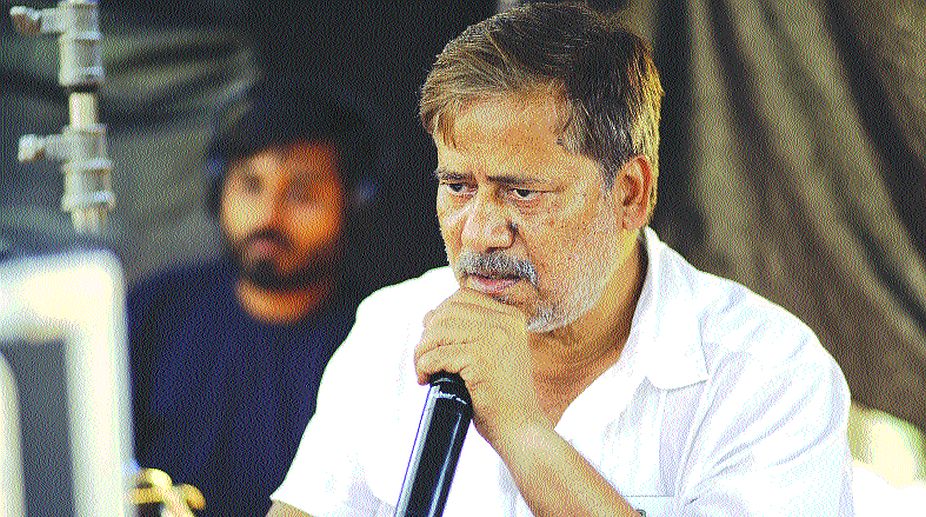Phanishwar Nath Renu returns to celluloid after a long gap as his short story Mare Gaye Ghulfam was adapted into Teesri Kasam by Basu Bhattacharya, 51 years ago. The man who has brought him back to a cinematic interpretation is Prem Modi whose Hindi film Panchlait is running in the city. It is based on a short story called Panchlait by Renu.
His first film as an assistant director was The Goal, a CFSI production starring Irrfan Khan as the protagonist, directed by Gul Bahar Singh. It won the Best Children’s Film Award at the 47th National Film Awards. Over time, he assisted noted directors like Suman Mukhopadhyay, Anjan Das, Anjan Dutt and Aparna Sen.
Modi’s first feature film, Arjun – Kalimpong E Sitaharan was a thriller for teenagers made in Bengali. The shy director opens up on what made him take up a Renu story for his second feature film and more. Excerpts from an interview:
Q.) What motivated you to do a film based on a Phanishwar Nath Renu story?
I grew up studying Phanishwar Nath Renu’s stories in school and I always had an inclination towards literature as I was raised in Bengal. This time around I wanted to reach out to a larger audience hence the medium had to be Hindi and what better story than Renu’s creation. The simplicity in his literature and the beauty with which he portrays our cultural roots is hard to miss. He is a stalwart of Hindi literature and it is an honour to bring his story on screen.
Q.) How do you think today’s audience will respond to this kind of film at a time when there is electricity everywhere and the concept of Panchlait is completely alien to most?
I am aware that today’s generation is all about social media but we cannot ignore basic human emotions. We still have emotions and we still like small and simple things. Human emotions will never change and this film is all about that. People will relate to this film and am sure they will love the simplicity of that era. We may not aspire for a Panchlight in big cities but we know the pain of chasing a dream and the joy of fulfilling a desire.
Q.) What is Panchlait all about?
The storyline is straight from the Hindi heartland. I am sure audiences around the country will relate to it. It was important to preserve the same regional flavour and philosophy upon which Renu’s stories are based. It is a slice-of-life drama surrounding Panchlait (colloquial of Panchlight — Petromax lamp) as the title suggests. The lamp is a precious commodity in villages and remote parts of our country not just as an item of utility but a thing of pride. It is used mostly in village community hubs and panchayats.
Q.) Is it a ‘period drama’ considering that it deals with a village ambience where electricity has not entered?
It is set in the fifties in a small village of North India. Panchlait traces the journey of an otherwise happy-go-lucky cast of people known as Mahato Tola who gather together in pursuit of the coveted Panchlait as theirs is the only community in the entire village, which does not have one.
Q.) There is a romantic sub-plot too, I guess?
Alongside the heartwarming plot a beautiful and ethereal subplot of romance is interspersed through the story of the protagonist, Godhan, who woos his lady love Munri in a rather bold fashion for his time and place. It leads to his expulsion from the village yet he is the only person who knows how to operate the Panchlait.
Q.) Where did you shoot the film since it is set against a village backdrop?
We shot this film in real places to keep the real vibe of Renu’s story alive. It is a small town in Jharkhand called Deoghar and we shot mostly within 50 km around that area and interiors of it. The shoot by itself was a huge challenge. It is a place where electricity is still a crisis, we had to keep to electricity timings, roads are still not concrete and getting to the location would be a huge feat. A large number of locals would gather everyday and crowd management would become a task. But now it all feels rewarding.
Q.) What method do you follow as a director — workshops before the shooting or script-reading sessions with the actors?
I am a very flexible person and taking inputs from my actors and crew members comes to me almost naturally. I believe filmmaking is a collaborative process. That said we had to be on the same page and reach the same goal. The rest of the process is almost always the same — it is a drill including script reading sessions, workshops, rehearsals et al. I had my actors interact with local people and village folk to understand their mindset, lifestyle and especially their diction. In fact I encouraged them to meet senior people from the village who could help my actors understand the bygone era as well.
Q.) What statement are you trying to make through the film?
Honestly, I am not here to preach something through the film or educate the audience and I believe people come to watch a film primarily for entertainment. Having said that, I also wanted to do justice to Renu’s story as well as wanted to show the real essence of our country through this film.
